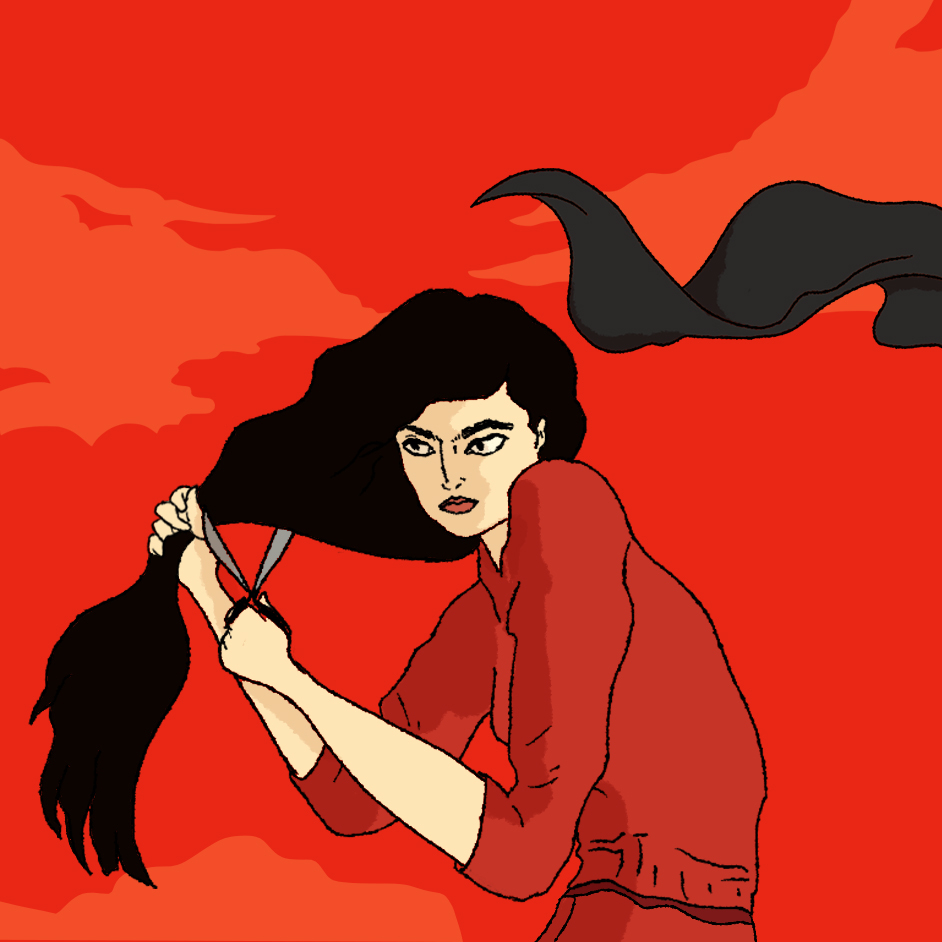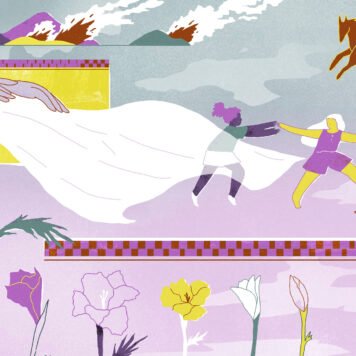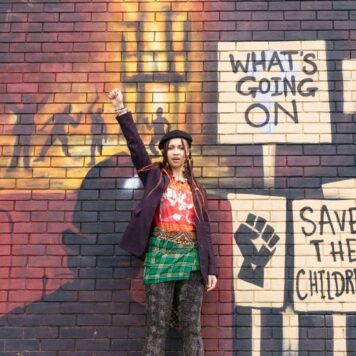The roosari is a loose scarf that most women in Iran wear to satisfy the requirement of being mandatorily veiled.
On 13 September 2022, a random member of the Islamic Republic of Iran’s morality police thought Mahsa Zhina Amini was wearing her roosari wrong and arrested her. On 16 September 2022, Mahsa Zhina Amini died after witnesses claimed she was subject to severe beatings while in police detention. The death of Mahsa Zhina Amini caused an eruption of grief from Iranian people across the Islamic Republic of Iran (IRI).
Iranian lives have always been cheap in the IRI – political dissidents, influential academics, journalists, LGBTQI+ people, and religious minorities have been regularly disappearing into prison cells since the 1980s following the 1979 revolution in Iran, when the IRI was established.
But the extrajudicial killing of a veiled woman at the hands of IRI forces is an exceptional assault against the careful construction of the identity of the ideal Iranian female citizen in post-revolutionary Iran.
In 1981, the veiled woman was a symbol of rebirth and purity borne from a new Islamic Republic. She was an embodiment of the new Iranian state, and would be protected in the IRI. But by 2022, the IRI killed a veiled woman for not being veiled enough.
A brief history of the veil in the IRI
The 1979 revolution in Iran was the result of a coalition of opposition parties and movements against the corrupt and brutal regime of Mohammed Reza Pahlavi (the last Shah of Iran). The Islamists were a significant faction in that opposition.
But according to Iranian writer and politics professor Sepehr Zabih, the “popular revolution based on a broad coalition of all anti-Shah forces was soon transformed into an Islamic fundamentalist power-grab.”
A significant feature in the Islamist power grab was its support amongst veiled women that had been marginalised within pre-revolutionary Iran. Ruhollah Khomeini, the political leader of the Islamist faction that opposed the Shah, declared that the veiled women of Iran had been crucial in the delivery of the revolution. He further claimed that the veil was the symbol of post-revolutionary Iran. On 7 March 1979, one of Khomeini’s first actions in his institutional power grab was to mandate the veil for women.
Iranian women immediately launched a six-day demonstration across Iran to protest the enforced dress code on 8 March 1979. The protesters against mandatory veiling perceived the edict as an attempt to sideline women from the social and political life of the IRI. Protests against mandatory veiling were initially successful, but by 1981 it was codified by law. By 1983 unveiled women could receive a whipping of “up to 74 lashes” if they didn’t wear the veil.
The virtuous veiled woman and state-building in the IRI
My mother grew up in Pahlavi’s Iran. My mother listened to the Beatles, she had a crush on Tom Jones, and she wore the latest Western fashions. She never wore a roosari; she never needed to in her Iran.
She was what Khomeini would have called a Pahlavi doll. A woman that was subject to Westoxification; an anti-Iranian woman that proudly flaunted herself as a distraction and corruption to righteous Iranian men (a characterisation that my mother stridently objects to).
The IRI was formed as a rejection of the cultural and political order of Western, capitalist powers. It was founded within an Islamist-Marxist framework that sought to nationalise Iranian feminism. Accordingly, Ali Shariati (the ideological architect of the IRI state) formed a language of female empowerment that realised “progressive human rights” that were uniquely Iranian and anti-Western.
For Shariati, the freedom and justice of the IRI could not be complete if Iranian women remained beholden to cultural colonialisation in the form of Western fashions and sexual liberation.
Iranian female empowerment in the IRI could only be achieved with material and spiritual enfranchisement via Islam. IRI women were not to replicate the behaviours of Western women. Instead, women in the IRI were to draw inspiration from the Prophet Muhammed’s daughter, Fatima, as a source of emulation in their code of conduct.
The requirement to wear the veil within Islamic theology is subject to interpretation. But Khomeini, in his extensive writings about veiled women, mainly associates the veil not with Islamic practice, but with an earnest and virtuous form of Iranian patriotism in the IRI. According to the Islamists, veiled women loved Iran because they visually embodied the rejection of the cheap moral values, shallow political culture, and foreign imposed beauty standards of the West.
Pahlavi’s dolls, in contrast, had freedom – but according to Islamists, it was a freedom that was only used to frolic, gamble, and drink alcohol. Women in the Islamic Republic had a mandated dress code, but they were free to participate in the political and social culture of the IRI truly and meaningfully.
The codification of female citizenship often sets out the normative agenda of a new state. In the IRI, the purpose of the veiled woman was to reject the emulation of the Pahlavi doll. The veiled woman was to act as the very embodiment of the purity and ideology of the Islamic Republic.
But in return for representing the new IRI, Iranian women would be protected and rewarded by the state. The death of a veiled woman in 2022 shows the hollowness of the IRI’s ultimate legacy in the protection of its obedient female citizens.
Veiled threats in a roosari
I spoke to three Iranian women who had lived most of their lives in the IRI trying to live up to that embodied ideal of Iranian womanhood. All three left the IRI in the last ten years to either escape religious persecution or seek educational opportunities outside of Iran. Zarrin was a teenager during the 1979 Revolution and is older than Parmis and Noora, who were born after the 1979 revolution and lived in the IRI until they left as teenagers.
According to Zarrin, Noora, and Parmis, the death of Mahsa Zhina Amini is shocking. This is because Mahsa Zhina Amin was a veiled woman that had been obedient to the IRI, but who had still been killed.
Subscribe to shado's weekly newsletter
Exclusive event news, job and creative opportunities, first access to tickets and – just in case you missed them – our picks of the week, from inside shado and out.

Parmis tells me, “I saw the pictures of Mahsa Amini. She was more covered than 90% of the women I ever saw wearing the roosari in Iran.” Zarrin agrees; “a lot of women wear the roosari somewhere past the middle of their scalp, with their hair trailing out at the bottom of their scarf.”
By all accounts and reports of her arrest, Mahsa Zhina Amini was wearing the roosari. But Zarrin tells me that sometimes “the way you wear the roosari in one part of town is not acceptable in another part of town.” Veiled women in the IRI had tenuous protection from the state – and it was dependent upon the discretion of state agents and the people around them what constitutes an acceptable roosari.
Admonishments for not wearing the roosari properly are also common in the IRI at the hands of the morality police. But Noora recalls from her years living in the IRI, “the police might take you to the station, you paid a fine, and then you wrote a letter to apologise. That was it, it was scary, but you never thought it would be fatal.” The death of Mahsa Zhina Amini is shocking to all three women because it came with the realisation how close they had all been to more imminent danger.
Conspicuous acts of rebellion and the proximity to Western values
Iranian girls in the contemporary IRI are taught they wear the veil as a symbol of their purity but also to not morally mislead men. Parmis and Noora tell me that the first time they heard this was when they were nine years old.
Parmis and Noora belong to families who worked to unravel the brainwashing that they learnt in school about the equality of women – but only in the privacy of their homes. Parmis says, “my mother would warn me that these are conversations that stay at home.”
The great irony of the veil and state-sanctioned rejection of Westernisation in the IRI is that it’s also made an individual’s proximity to the West a source of social capital. According to all three women, people would wear the roosari as an accessory to bleached blond hair and Western branded clothing.
According to Zarrin, “women have to wear the roosari but they wear Western clothing to signal to others either wealth or education.” She laments the perceived need for this performative Western-ness, and blames it on the draconian regime. “It’s sad, because we have a rich culture and beautiful women, but mandatory veiling has meant Iranian women feel like looking Iranian makes them less than in the eyes of society.”
According to Noora, “we all craved to be in the West. Not because we hated Iran but because we were subject to an economic and political system defined by corruption, and we had no freedom of expression. The West promised an alternative.”
All three women now live outside of Iran, but all speak about the fact that Iran wasn’t and isn’t the problem: it’s the system in place that serves to marginalise its citizens.
Celebrating the legacy of Mahsa Zhina Amini with protest
Noora joined the recent demonstrations at her university in the United States to bring attention to the extrajudicial killing of Mahsa Zhina Amini. She said there was a conflict between organisers and attendees – the organisers wanted to only talk about Mahsa Zhina Amini and her death. But other demonstrators wanted to talk about how the IRI is failing its citizens – most of all, its women.
Noora says, “The problem with the veil is how it is used to underline the IRI’s patriarchy and corruption. The people of Iran are exhausted, but the women are the most tired. We bear the major brunt of economic deprivation, limited freedom of movement and expression – and even when we follow the rules, they kill us.”
Zarrin, who was a teenager in Iran during the 1979 revolution, has seen numerous protests since the inception of the IRI. “Every family, in every corner of Iran, has gained a martyr in their home due to the corruption and cruelty of the IRI.”
She continues: “Every few years, people get fed up, they go to the streets, they get killed. People then see the cost of speaking out and go home,” she says. “Mahsa Amini is an innocent victim, but her death was the latest trigger. The protests are the latest exhale of frustration and anger from everyone in Iran.”
Every time there has been even a whisper of a protest in Iran, since my parents fled to Australia in 1983, my Dad says: “this is the one, this is the one that topples them [the regime], we’re going home.” After a lifetime of the same promise from my Dad that the regime will be overthrown, Zarrin’s scepticism feels safer.
Usually, my sister and I ignore my Dad when he makes the same unfulfilled proclamation about our return to Iran, we stand in mock celebration and toast our oat flat whites to a “next year in Tehran.” In many ways, it has felt pointless to encourage a hope that my refugee parents will be able to return back to their homeland.
But Parmis believes these protests are different. “You know, in high school, there would be pictures of Khomeini in all our textbooks. We would all draw make up on his face. When my Mum saw that, she got so scared. She begged me not to do it again, she was scared about what would happen to me. But then, I saw the protests – and there were led by high school girls, and they were tearing up photos of the Khomeini, without fear, on video. I don’t know how Iranian women can turn away and betray that bravery.”
At first my sister and I engaged with trepidation; just cursory glances at the news stories about the latest protests in Iran. But slowly we started a flurried correspondence of forwarded news clips and social media posts about the protests. Protestors in the IRI weren’t going home – IRI forces stormed universities and the streets – but Iranians have not stopped protesting, even in the face of imprisonment and death. My sister and I could no longer deny our hope from growing as Iranian women in the IRI, and its diaspora, have relentlessly continued the legacy of Mahsa Zhina Amini through protest.
Younger Iranians make constant declarations across social media that they would rather be dead than live under the conditions of the IRI. Day by day, older generations in the IRI who were previously scared of challenging the status quo are being emboldened by Iranian youth. Older women are walking the streets of their cities without the roosari – challenging the morality police to arrest them – whilst Iranian women and men shout support. Oil workers and truck drivers in the IRI have gone on strike in support of the protests.
For the last month, the regime has set cities on fire (especially cities that have a higher proportion of the IRI’s ethnic minorities, such as Kurds, Baluchis and Azeris) but Iranians have not gone home. They have not betrayed the bravery of other women and men who have protested; they have instead gained new martyrs.
It has been hard for my sister and me to deny these protests feel different. My Dad may finally be right; we may be going home – because Iranian women are in the streets toppling the regime.
NOTE: The names of the interviewees included in this piece have been changed to ensure safety for those individuals (and their families that remain in the IRI).
What can you do?
The situation in Iran is ongoing. Protestors in Iran have repeatedly asked the global community to continue to share images and stories of the protests.You can continue to follow the protests via the following media outlets:
And read more about how the regime has also started reprisals against ethnic and religious minorities in the IRI in reaction to the protests by following Iran Press Watch.









